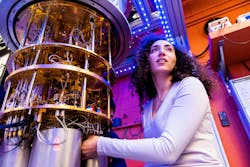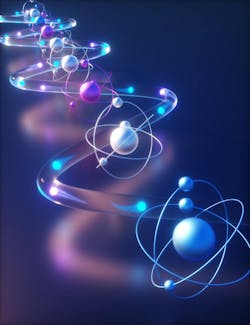What inspired your work with photon-shuttling interconnects?
Aziza Almanakly: A traditional computer has a motherboard, memory chip, a central processing unit (CPU)—and all of these different components of the computer need to work together to carry out operations. A quantum computer will also require communication between multiple processors. Classically, you shuttle around information with currents in wires. But for quantum computers, transferring quantum information is a whole science of its own because quantum information is very fragile—we’re talking about maintaining a single photon’s coherence (ability to hold quantum information for a specific amount of time). Styles of point-to-point quantum interconnects exist—they connect a chip to another chip—but there hasn’t been a scalable all-to-all interconnect option.
So we designed a new style of quantum interconnect by leveraging waveguide quantum electrodynamics. We can have several chips coupled to a waveguide, which is similar to a wire that can extend as long as we need, so that we can connect all of these chips together in an all-to-all fashion. By emitting and absorbing photons in a particular direction, we can network many chips together on-demand.
Can you describe the basic concepts and design work involved?
Almanakly: A qubit is a quantum mechanical system composed of two energy levels (or states). The simplest example we get from nature is an atom, which can have many energy states, but we can select two to be the ground and excited states. Qubits obey the laws of quantum mechanics. The first principle I will describe is superposition. An atom in a superposition state behaves this way—half of the time we’ll measure it in the ground state and the other half in the excited state.
There are many ways to form these two-level systems—I work with a superconducting qubit, which we engineer; it doesn’t come from nature. It’s a circuit and, once we get to low enough temperatures, we can actually identify these ground and excited energy levels—it’s why we call them artificial atoms. We can design them with energies and properties we need.
When an atom is excited and decays, it emits a photon. The same sort of physics is happening here. We couple a qubit to a waveguide and if we excite this qubit, it emits a photon at a frequency that’s determined by the difference between the energy levels. The ground state and excited state are 5 GHz apart in our setups, and in our communication modules we have not just one atom but several atoms with connections (couplings) between them. You can think of our module as a molecule—instead of an artificial atom, it’s an artificial molecule. By getting these atoms to interact with each other in the way we want, we can get them to emit a photon into the waveguide in the direction we choose. This was the first experiment we did a couple of years ago.
.
Then we put two of these artificial molecules on the same waveguide and sent photons back and forth between them and used the photons to generate entanglement. Entanglement is a correlation between two qubits that aren’t necessarily right next to each other. If you have two qubits in an entangled state and you measure one, you know the state of the other; it’s a statistical property and by using photons, you can create entanglement between two qubits that are far apart. Entangled qubits “share” one photon, so either you measure a photon of energy at one qubit or at the other. Entanglement is a key resource for quantum computing in general, and generating remote entanglement enables the implementation of operations between two qubits that aren’t local to each other—for the purpose of distributing computation over different modules.
We’re using single photons at microwave frequencies. People tend to think of photons as coming from visible lasers—but microwaves are also an electromagnetic field at a different frequency, and if you go to low enough temperatures you can measure single microwave photons. But there is a catch: there is more thermal noise at microwave frequencies, which is why we need to go down to such low temperatures (about 10 mK).
How do you create the interconnects?
Almanakly: We’re using superconducting qubits that operate at microwave frequencies, so the system involves microwave cables and electronics inside a dilution refrigerator. A superconductor is a material through which current flows without resistance. Superconductivity is a property of certain materials at very low temperatures. We use superconducting aluminum to create our qubits.
We take advantage of the consequences of superconductivity to engineer “designer” atoms. In our superconducting quantum interconnect, we have one module of superconducting qubits in one microwave package, and another module in another microwave package, and we connect them with a microwave cable through which we send photons. Using directional photons, we generated entanglement over a distance of about 10 centimeters.
What does your interconnect mean in the grand quantum scheme of things?
Almanakly: Our field is moving from the control of single qubits now to the engineering of larger quantum systems, which is another quantum problem in and of itself. A new field called quantum engineering is emerging and it’s where our research is going. We get to define this field. How do we control many qubits at the same time and perform high-fidelity operations for computation? This experiment works toward building large quantum systems for distributed computation. Other interconnects exist, but ours is a new variety that has different limitations—it’s not perfect. It’s another tool in the toolbox. I think a quantum computer architect in the future will find it useful for the computer processor they’re designing.
Any a-ha! moments or surprises along the way?
Almanakly: Once we optimized the protocol for emitting/absorbing the photon, the entanglement generation was straightforward. We simply stopped the process for emitting the photon halfway through—this meant half of the time we would measure the photon in the waveguide (the photon was emitted) and the other half of the time we would measure the photon of energy in the qubits (the photon was not emitted). The theory I had done before for entanglement generation made me think it was going to be more complicated and I didn’t think it would work in this setup and within the time I had. But my advisor, Professor Will Oliver, said to just try it the simplest possible way, and it actually worked—sometimes the easiest way is the best way.
It was very difficult to tune up all of these qubits—this experiment has 16 qubits in total, and while you’d think it’s redundant it’s really not. Each qubit has a personality of its own and throws temper tantrums, and we need to control all of them with precise pulses. To do this, we turned to machine learning and used a reinforcement learning algorithm to optimize all of the control pulses that we send to our qubits to run the experiment. It was pretty fun to see how much better the algorithm could do than me in tuning up the experiment reliably and repeatedly.
Any other challenges?
Almanakly: Even running the fridge itself was a challenge. The experimental apparatus is like a living, breathing system. While I was setting everything up, even getting to the point where I had two chips that met all the requirements and all the control lines were working took between six months to a year because the fridge was acting up.
We use a dilution refrigerator, which mixes helium-3 and helium-4 isotopes that allow us to seemingly magically cool down to temperatures around 10 mK. We call it a circulation—there’s a closed loop of these gases circulating through these pumps that cools down the system. The beating heart of the system is the dilution unit/mixing chamber where the two isotopes mix. And while I was doing this experiment, we had to do open-heart surgery on the fridge to replace the inside of the unit.
Our fridge had just been installed when I started, and I helped build it up with all the cabling and equipment that goes inside it—it looks like a chandelier. We’d already spent so much time building it up, and three years later it broke. So we had to take it apart and put it back together again.
The fridge itself is a feat of thermodynamics that needs specialized pumps and compressors. The rest of the lab resembles a standard microwave engineering lab—we operate at around 5 GHz. The lab looks like a server room with the tall shelves and electronic equipment and lots of cables to the fridge. And lots of computers—we need them to control a quantum computer. We’re not getting rid of those anytime soon.
Coolest part of quantum engineering?
Almanakly: I really like the research. In quantum engineering we use both fundamental physics and technological advancements, which go hand in hand. We can use fundamental physics as resources for technology, but it also works in reverse. If we have new technology and better engineering, it can enable the discovery of new types of physics. It’s what I like about my project—it flows in both directions. The implementation of new physics can create new technology, but state-of-the-art quantum technology allowed us to demonstrate this new physics in the first place. I really like being at this interface—working within the lab and seeing the concepts I’ve learned come to life, and I like interacting with a living, breathing physical system.
Timeline to use?
Almanakly: We are probably 10 to 15 years out from a large-scale, fault-tolerant quantum computer that can actually have useful applications. It’s a really difficult problem and a lot of people from different fields are coming together to work on it.
There was an exciting proof of concept a few months ago that reinvigorated our energy: quantum error correction. Because qubits are very fragile—they’re susceptible to lots of noise caused by decay to their environment and introduced by operations—to have reliable computation, you need to be able to correct these errors. In classical, digital bits encoded by transistors, there are very few errors; it isn’t really a problem with classical computation. The idea is instead of having just one qubit encode your information, you use multiple qubits to create redundant information so you can catch an error and fix it. The proof-of-principle demonstration of quantum error correction was accomplished by Google Quantum AI last year. When they increased the number of qubits, the logical error rate of the system decreased. They made a system of noisy parts bigger, with more noisy parts, and the system behaved with less error than when it was a smaller system. Pretty amazing, and it shows a path forward for quantum technology.
FURTHER READING
A. Almanakly et al., Nat. Phys. (2025); https://doi.org/10.1038/s41567-025-02811-1.

